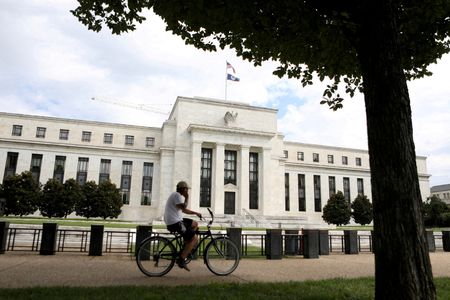(Reuters) – Federal Reserve policymakers are signaling a pause in hiking interest rages for another couple months as they wait for a resolution of mixed signals: strong economic data, signs of progress on still-stubbornly high inflation, and the potential for the recent rise in longer-term borrowing costs to do some of their work for them.
“I believe we can wait, watch and see how the economy evolves before making definitive moves on the path of the policy rate,” Fed Governor Christopher Waller told the European Economics & Financial Center Seminar in London.
The “conundrum,” he said, is that American households are not pulling back on spending despite a slowdown in wage growth; the “puzzle,” he explained, is illustrated by the heat in economic activity alongside cooling inflation.
It can’t continue this way, he said, but it’s too soon to know which way the data will break. Should the economy soften, he said, “we can hold the policy rate steady.”
If it continues to show strength or inflation stabilizes or reaccelerates, he said, “more policy tightening is likely needed despite the recent run-up in longer-term rates.”
Coming from one of the Fed’s most hawkish policymakers, the remarks were as near a guarantee as it gets that central bankers will hold rates steady for a second straight meeting when they next gather in Washington Oct. 31-Nov. 1 — but at the same time that they will leave the door open wide for a rate hike by year end.
As for interest rate cuts, he said, “I don’t really want to get into talking about cutting rates when we maybe haven’t even stopped raising them.
Speaking at a separate event at Queens College, New York Fed President John Williams offered a similar perspective.
“Right now we need to keep this restrictive stance of policy in place for some time to get” inflation down, he said, adding that the Fed has made progress lowering inflation but still has a ways to go.
The Fed drove its policy rate up aggressively last year to bring inflation down from 40-year highs, in big chunks to start and, most recently, by a quarter of a percentage point in July, to the 5.25%-5.50% range where it currently stands.
Fed policymakers are weighing whether that level is high enough to get inflation on a path to their 2% goal.
Inflation by the Fed’s preferred measure of the personal consumption expenditures price index, which hit a peak of 7% last year, is now around 3.5%, Waller estimated on Wednesday, with underlying inflation excluding food and energy at 3.9%.
Some Fed policymakers, including Waller, point to the nearly full percentage point rise in the yield on the 10-year Treasury note since the Fed’s July rate hike, saying the elevated long-term market rates will likely blunt demand and economic activity, leaving less for the Fed to do.
Complicating their assessment of whether rates are high enough are the stories policymakers and their staff pick up from businesses and households in their districts showing that growth may already be weakening.
The Fed’s most recent “Beige Book” report, published on Wednesday, showed overall regional Fed banks reported little change in economic activity in the six weeks or so ended Oct. 6, a tepid assessment underscoring the divide between “hard” data showing a resilient economy and the on-the-ground anecdotes that tell a different narrative.
(Reporting by Ann Saphir, Michael S. Derby and Dan Burns; editing by Jonathan Oatis)

